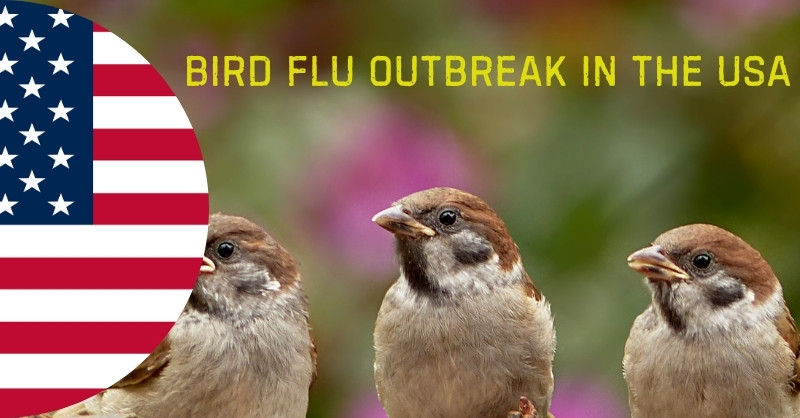Bird flu outbreak USALatest Cases, Impact, and Comprehensive Safety Guide
Bird flu outbreak USA: Introduction
The ongoing bird flu outbreak in the USA has escalated into a significant public health and agricultural concern, demanding heightened vigilance and proactive measures. Specifically, the H5N1 strain, a highly pathogenic avian influenza (HPAI), is driving this outbreak, affecting not only poultry farms but also raising concerns about potential human health risks. Therefore, understanding the intricacies of this outbreak, from its spread and impact to the necessary preventive actions, is crucial for safeguarding both animal and human populations.
Bird flu outbreak USA: What is Avian Influenza and the H5N1 Strain?
Avian influenza, commonly known as bird flu, is caused by influenza A viruses that primarily infect birds. To elaborate, these viruses are classified based on two proteins on their surface: hemagglutinin (H) and neuraminidase (N). Among these, the H5N1 strain is particularly concerning due to its high pathogenicity, meaning it can cause severe illness and death in infected birds. In contrast, unlike some other strains that may cause mild symptoms, H5N1 can lead to systemic infections, affecting multiple organs.
Furthermore, the virus spreads through direct contact with infected birds’ saliva, nasal secretions, and feces. Notably, wild birds, particularly waterfowl, can carry the virus without showing symptoms, acting as reservoirs and contributing to its widespread dissemination. As a result, this makes control and eradication challenging.
The Escalating Spread: Recent Cases and Geographic Distribution
Recently, the bird flu outbreak in the USA has witnessed a surge in cases across numerous states. For instance, poultry farms, especially those dealing with chickens and turkeys, have been severely impacted, leading to large-scale culling to prevent further spread. Additionally, the virus has also been detected in various wild bird species, including waterfowl, raptors, and scavengers, indicating its extensive reach.
Geographically, the outbreak has shown a broad distribution, affecting both coastal and inland states. This is largely due to the migratory patterns of wild birds, which play a significant role in this spread by carrying the virus across vast distances. Consequently, monitoring and tracking these movements are essential for predicting and managing the outbreak.
Bird flu outbreak USA: The Severe Impact on Poultry and the Agricultural Economy
Beyond animal health, the consequences of the bird flu outbreak significantly impact the agricultural economy. For example, the necessary culling of infected poultry leads to substantial financial losses for farmers, disrupting supply chains and causing shortages of poultry products.
- Economic Losses: In particular, farmers face direct losses from culled birds, as well as indirect losses from decreased production and increased biosecurity costs.
- Supply Chain Disruptions: As a result, the reduction in poultry and egg production leads to shortages, resulting in rising prices for consumers.
- Increased Biosecurity Measures: To address this, farms must implement stringent biosecurity protocols, including enhanced sanitation, restricted access, and protective gear, adding to operational costs.
- International Trade Implications: Moreover, outbreaks can lead to trade restrictions, impacting exports of poultry products and further straining the agricultural sector.
Understanding the Symptoms of Bird Flu in Humans: A Critical Aspect
Although human infections with H5N1 are relatively rare, they can be severe. Therefore, early detection and prompt medical intervention are crucial. Typically, human symptoms resemble those of seasonal influenza but can progress rapidly to more severe conditions.
- Initial Symptoms: Commonly, fever, cough, sore throat, muscle aches, and fatigue are initial symptoms.
- Respiratory Complications: Subsequently, shortness of breath, difficulty breathing, and pneumonia can develop rapidly, often requiring hospitalization.
- Other Symptoms: In some cases, individuals may experience nausea, vomiting, diarrhea, and conjunctivitis (eye infections).
- Severe Cases: Ultimately, in severe cases, acute respiratory distress syndrome (ARDS) and multi-organ failure can occur, leading to death.
Comprehensive Prevention Strategies: Protecting Yourself and Your Birds
To prevent bird flu infection, a multi-faceted approach is required, encompassing personal hygiene, biosecurity measures, and public health initiatives.
Personal Protective Measures:
- Avoid Contact: First and foremost, stay away from sick or dead birds, and avoid areas where birds congregate.
- Hand Hygiene: Additionally, wash hands frequently with soap and water for at least 20 seconds, or use an alcohol-based hand sanitizer.
- Food Safety: Furthermore, cook poultry and eggs thoroughly to kill any potential viruses. Ensure that poultry reaches an internal temperature of 165°F (74°C).
- Protective Gear: Lastly, if you work with poultry or are in close contact with birds, wear appropriate protective gear, including gloves, masks, and eye protection.
Bird flu outbreak USA : Biosecurity Measures for Poultry Farms
- Restricted Access: To begin with, limit access to poultry houses and enforce strict hygiene protocols for visitors.
- Sanitation: Next, regularly clean and disinfect equipment, vehicles, and facilities.
- Bird Isolation: Similarly, separate new birds from existing flocks and isolate sick birds immediately.
- Water and Feed Management: Moreover, ensure that water and feed are protected from contamination by wild birds.
- Surveillance: Finally, monitor bird populations for signs of illness and report any unusual deaths to authorities.
Government and Public Health Response: A Coordinated Effort
Currently, the CDC and USDA are working closely to monitor and control the bird flu outbreak. Key initiatives include:
- Surveillance and Monitoring: For instance, conducting surveillance of poultry farms and wild bird populations to track the spread of the virus.
- Testing and Diagnostics: In addition, providing rapid testing and diagnostic services to identify infected birds and humans.
- Vaccine Development: Furthermore, researching and developing vaccines for both poultry and humans to provide protection against the H5N1 strain.
- Public Education: Additionally, conducting public awareness campaigns to educate people about the risks of bird flu and how to prevent infection.
- Biosecurity Guidelines: Lastly, providing guidance and resources to poultry farmers on implementing effective biosecurity measures.
What to Do If You Suspect Exposure or Infection:
- Isolate Yourself: If you suspect you have been exposed to the virus or are experiencing symptoms, isolate yourself from others.
- Contact Healthcare Provider: Then, seek medical advice immediately and inform your healthcare provider about your potential exposure.
- Follow Medical Guidance: After that, follow the instructions of your healthcare provider and adhere to any prescribed treatment.
- Report Suspected Cases: Finally, report suspected cases of bird flu to local health authorities to facilitate tracking and containment.
Conclusion: A Call for Vigilance and Preparedness
In summary, the bird flu outbreak in the USA presents a significant challenge, requiring a coordinated and proactive response. By staying informed, practicing proper hygiene, implementing robust biosecurity measures, and adhering to public health guidelines, we can mitigate the impact of this outbreak and protect both animal and human health. Above all, continuous monitoring, research, and collaboration are essential for effectively managing and controlling the spread of avian influenza.



